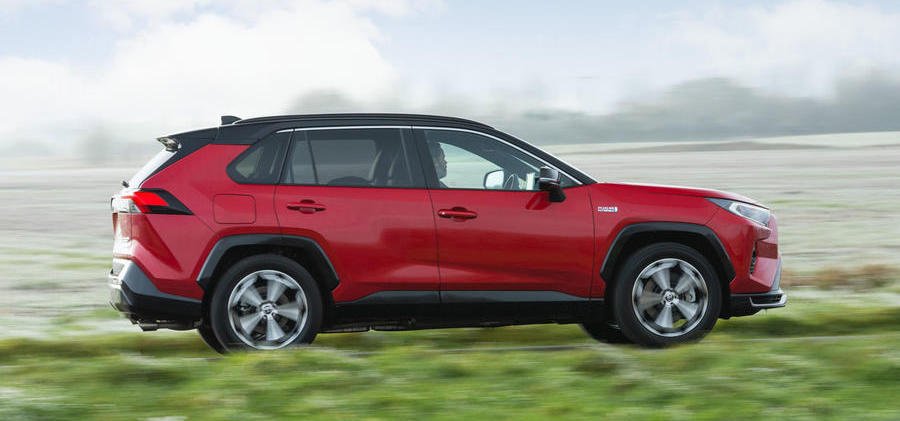What is it?
Plug-in hybrids such as this new Toyota RAV4 are an interesting phenomenon.
With the ability to run for short periods of time on electricity alone you can see, on the one hand, how they might appeal as a safe, considered stepping stone in the journey from petrol power to a bonafide EV. On the other, they could just be nothing more than a cynical means of slashing your company car tax obligations - and one that's a mere legislation change away from losing that prime positioning, too. But whatever your thoughts on the moral worth of these potential Cayman Island cars might be, this latest RAV4 PHEV is a pretty impressive example of the breed.
Mechanically speaking, it's not too dissimilar to the standard RAV4 Hybrid. There's a 2.5-litre, four-cylinder petrol engine up front that's mated to an electric motor, and which together drive the front wheels through an e-CVT. At the rear axle, there's a second, smaller electric motor that lends the Toyota all-wheel-drive capability. And, unsurprisingly, it's based on the Japanese firm's TGA-K architecture.
Of course, there are some key differences. The petrol engine now develops 182bhp instead of 176bhp; and the front electric motor's output has been upped from the 118bhp figure it makes in the regular RAV4 Hybrid, to 180bhp here. The rear motor still produces 54bhp, but combined they lend the RAV4 PHEV a system output of 302bhp - making it the most powerful model in the range by a pretty hefty margin.
The lithium-ion drive battery is obviously larger, too. It has a gross capacity of 18.1kWh - pretty beefy by current PHEV standards - and is mounted beneath the floor to lower the car's centre of gravity. Toyota claims a WLTP-certified range of 46 miles (so it slots into that desirable 6% BiK bracket), while a full charge can be delivered in 2.5 hours from a dedicated wallbox.
What's it like?
You've got a choice of four different powertrain operating modes here, which I guess sounds quite fussy but actually they all work quite well out on the road. Start the car and it defaults to pure EV mode. Provided there's enough juice in the battery you can travel at speeds of up to 84mph, and even if you hit the kickdown switch to summon a well of acceleration, the ICE motor won't spark up. Toyota claims a 0-62mph time of 10sec when running on battery power, and performance is brisk enough to keep pace with the traffic. Throttle response is excellent, and forward progress arrives in a smooth, seamless fashion.
Next is Auto EV/HV mode, which is effectively the same as regular EV mode, apart from the fact that the petrol engine will pipe up if you really mash the throttle. The transition from one power source to another is really smartly governed, and the petrol engine only makes itself heard if you stand on the throttle for prolonged periods of time. Then there's HV mode, where the RAV4 runs as a regular hybrid (and a quick one at that); and finally there's charge mode, which, well, charges the battery up while you're driving.
One aspect of running a plug-in car that can really set your teeth on edge is the draining effect that cold winter weather can have on electric range. The Citroen C5 Aircross PHEV I currently have as a long-termer, for instance, has been struggling to get more than 17 miles from a full charge - which is significantly less than its minimum 33-mile claim. Preconditioning - the process of warming the car up while it's still plugged in - is key here, and when run as such, the RAV4 PHEV really impresses.
Admittedly, I wasn't able to match its 46-mile claimed range. But on a test route that took in all manner of dual carriageways, fast country A-roads and 20mph village lanes, the Toyota covered 36 miles before its battery gave up the ghost. And that was without me making a conscious effort to maximise efficiency, either. Then, when the car reverted back to running in regular hybrid mode, it still managed to average 49mpg over the remainder of our 90-mile test route.
It's an impressive system, this; performance, efficiency and electric range are all really strong. Provided you have a home charger that you can plug into, I'd wager that trips to the petrol pump will be few and far between. That this powertrain is implemented into a car that also rides comfortably, handles smartly, and steers through a pleasingly thin-rimmed wheel that's accurate in its responses and really quite nicely weighted is an added bonus. There's loads of room in the second row, too, and the boot is still a usefully large 520-litre affair despite the packaging tweaks made to accommodate the bigger battery.
Should I buy one?
The only snag is the price. It starts at £47,395, so it's a natch more expensive than the excellent plug-in Land Rover Discovery Sport that toppled rivals from BMW and Volvo in an Autocar group test recently. It's also a few grand pricier than the new Suzuki Across, which is effectively the exact same car only with a different badge on its nose.
Standard equipment is nonetheless generous, but it doesn't have the premium allure of those upper-class competitors - despite feeling exceptionally well-built. Nevertheless, this is an easily recommendable PHEV SUV - provided you're into such things.

